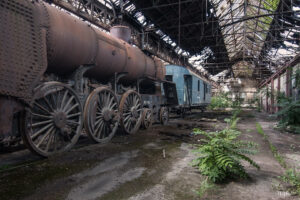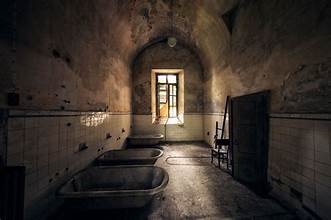
Urban exploration, also known as urbex, has grown into a fascinating hobby for many adventurers and history enthusiasts. It involves exploring abandoned places, forgotten buildings, and hidden spots in urban environments. The allure of these explorations lies in the discovery of unique finds that tell a story about the past. In this article, we’ll delve into some of the most intriguing urban exploration discoveries and highlight what makes these finds stand out.
1. Abandoned Places with Rich Histories
One of the most captivating aspects of urban exploration is uncovering abandoned places with deep historical significance. For instance, the Richmond Power Station in Virginia, once a bustling hub of industrial activity, now stands as a relic of the past. Its towering structures and intricate machinery offer a glimpse into the industrial era’s grandeur. Exploring such sites provides valuable insights into the evolution of urban infrastructure and the lives of those who once worked there.
Key Takeaway: The historical context of these sites adds depth to the exploration, making them more than just abandoned buildings but rather pieces of living history.
2. Hidden Art Installations and Graffiti
Urban explorers often stumble upon hidden art installations and graffiti that transform forgotten spaces into vibrant canvases. An excellent example is the Banksy Tunnel in London. This secretive location features artworks by the elusive street artist Banksy, offering a unique blend of urban decay and contemporary art. Discovering these hidden gems not only surprises explorers but also enriches their understanding of urban culture and artistic expression.
Key Takeaway: The presence of hidden art adds an element of surprise and creativity to urban exploration, showcasing how art can thrive even in neglected spaces.
3. Underground Bunkers and Shelters
Urban exploration often leads to the discovery of underground bunkers and shelters that were once integral to a city’s defense or emergency preparedness. The Wartime Bunker in Berlin is a prime example. Built during World War II, it now serves as a stark reminder of the city’s wartime past. Exploring such sites provides a chilling yet fascinating perspective on historical events and the lengths taken to protect urban populations during times of crisis.
Key Takeaway: These underground structures reveal the hidden layers of a city’s history and the strategies employed to safeguard its residents.
4. Forgotten Subway Stations and Tunnels
Abandoned subway stations and tunnels offer a glimpse into the hidden infrastructure of urban transit systems. For example, New York City’s City Hall Station, closed to the public in 1945, remains a beautifully preserved piece of architectural history. Its ornate tilework and grand arches stand in stark contrast to the modern, utilitarian design of today’s subway stations. Exploring these forgotten transit spaces highlights the evolution of urban transportation and the beauty of historical design.
Key Takeaway: Forgotten subway stations and tunnels reveal the architectural elegance and historical significance of past transit systems, often hidden from the public eye.
5. Secret Rooftop Gardens and Terraces
Urban explorers sometimes uncover secret rooftop gardens and terraces that offer a surprising oasis amid the concrete jungle. The High Line in New York City, though now a renowned public park, began as an overgrown railway track that urban explorers initially discovered. Such rooftop gardens demonstrate how green spaces can be integrated into urban environments, providing a peaceful retreat from the hustle and bustle below.
Key Takeaway: Rooftop gardens highlight the innovative ways cities can incorporate nature into urban landscapes, offering both aesthetic and ecological benefits.
6. Historic Theater and Cinema Halls
Abandoned theaters and cinema halls often stand as architectural marvels from a bygone era. The Loew’s Kings Theatre in Brooklyn, for instance, showcases opulent designs and intricate details that reflect the grandeur of early 20th-century entertainment venues. Exploring these spaces allows urban explorers to appreciate the artistic and cultural significance of historic entertainment venues, many of which have been lost to modern redevelopment.
Key Takeaway: Historic theaters and cinemas offer a window into the past, revealing the cultural importance of entertainment in earlier urban societies.
7. Old Industrial Facilities and Factories
Old industrial facilities and factories, once the backbone of economic activity, now provide a hauntingly beautiful backdrop for urban explorers. The Nara Dreamland in Japan, an abandoned amusement park, exemplifies this perfectly. Once a vibrant location, it now stands as a testament to past economic cycles and cultural trends. These sites often feature decaying machinery and overgrown landscapes, evoking a sense of nostalgia and mystery.
Key Takeaway: Abandoned industrial sites capture the transient nature of economic booms and the lasting impact of industrialization on urban landscapes.
Conclusion
Urban exploration reveals a world of hidden treasures and forgotten histories, each with its own unique story. From abandoned places with historical significance to secret rooftop gardens and hidden art installations, these discoveries stand out due to their blend of historical, artistic, and cultural value. By exploring these sites, urban explorers not only uncover forgotten pieces of the past but also gain a deeper appreciation for the evolution of urban environments. Whether you’re a seasoned explorer or a curious observer, the world of urban exploration offers endless opportunities for discovery and adventure.




